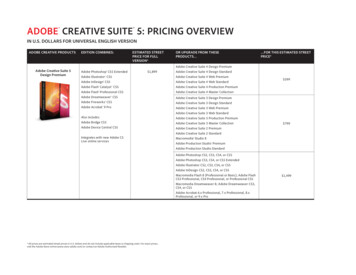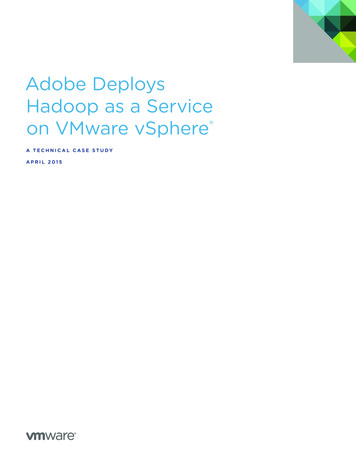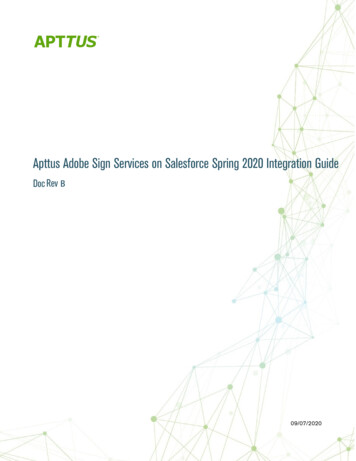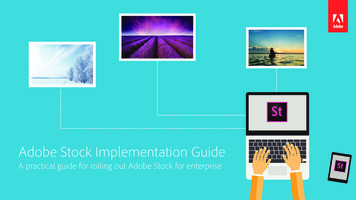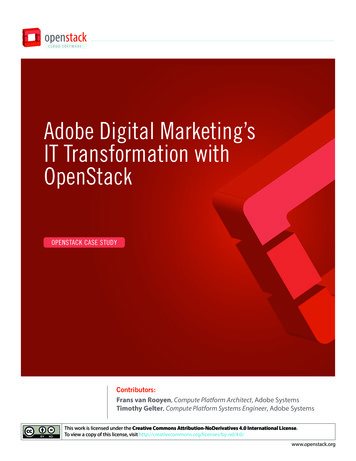
Transcription
openstack Adobe Digital Marketing’sIT Transformation withOpenStackOPENSTACK CASE STUDYContributors:Frans van Rooyen, Compute Platform Architect, Adobe SystemsTimothy Gelter, Compute Platform Systems Engineer, Adobe SystemsThis work is licensed under the Creative Commons Attribution-NoDerivatives 4.0 International License.To view a copy of this license, visit openstack.org
openstack Executive SummaryMost organizations have IT infrastructure that was leading-edge in the past but limitsopportunities in the present. New needs for agility, simplicity, security and resiliency oftenhighlight the gaps and limits in an IT infrastructure.The Technical Operations team in Adobe’s Digital Marketing group knew they needed to drivean evolutionary revamp that would take their infrastructure into leading-edge territory. Theyhad a fundamental goal -- to improve a core customer-facing business function – the AdobeMarketing Cloud.Adobe Digital Marketing and its Marketing Cloud provide SaaS digital marketingcapabilities to large B2B enterprises. Their Marketing cloud enables superior web experiencemanagement, analytics, social marketing, media optimization, testing and targeting, andcampaign management for hundreds of organizations around the world. As a core businessfunction, agility, resiliency, and innovation are key measures of success.Adobe’s environment was typical for many organizations – some VMware virtualization,paired with physical resources, across many datacenters worldwide. But that was no longerenough – Adobe needed to leverage their VMware infrastructure in a new way by shiftingtoward a leading-edge, fully-fledged private cloud g
openstack Challenges and OpportunitiesCustomers have some basic expectations of SaaS offerings. Rapid, incremental innovation A relentless emphasis on security Resiliency and performance in line with expectationsAdobe’s infrastructure teams rethought how they could meet these expectations. Theysaw the cloud as the best way to accelerate the full software development lifecycle. Fromsandbox (playing around) and development, to quality engineering, staging/beta, and intoproduction – the initial goal was to provide a consistent, abstracted layer that would beautomatically and seamlessly provisioned via a self-service model. From an operationalperspective, Adobe wanted to give developers, testers, and operational engineers aconsistent and reproducible experience from concept through to production.In addition, Adobe wanted to transform their IT infrastructure by consolidating resourcesand shifting toward software defined capabilities that abstract away many limitations ofbare-metal infrastructure. Adobe had already pushed traditional compute virtualization to itslimits, using VMware across the infrastructure, but wanted to also virtualize networking andstorage as well.For a couple of years, the Technical Operations team had explored options, experimentingwith various test and development scenarios, and began to see significant opportunities todeliver IT transformation.02www.openstack.org
openstack Exploring RequirementsAdobe realized that they could re-invent their IT infrastructure with a more automated privatecloud. It needed to include a cloud management layer and offer a robust self-service interfaceby which product teams could programmatically consume resources as needed.Their primary goal was to provide Infrastructure as Code, enabling operation and engineeringteams to consume this infrastructure in a standardized manner through a known language(JSON). By achieving this goal, their IT environment would become a software-defineddatacenter rather than one limited by hardware and manual processes.They had a few basic technical requirements to meet. VMware support – performance, resilience, and investment protection Network requirements – security, micro-segmentation, and true multi-tenancy Software-defined storage and networking – to drive down costs and complexityBeyond technical requirements, they had several objectives. Operational – ease management overhead, centralize the interface, consumeinfrastructure in a standardized, self-service model Cost savings – reduce manual intervention, product development and launchdelays, and achieve savings from overall standardizationof infrastructureAdobe preferred open source to avoid vendor lock-in, but to explore all opportunities,they also evaluated a few commercial offerings. They were ultimately looking for a wellestablished, proven option with a strong community and a robust roadmap.This transformation had the potential to provide both developers and end-users withmore elasticity, security, and efficiency. After a rigorous series of tests and evaluations,VMware Integrated OpenStack (VIO), offering a full, standard OpenStack distribution withintegration to VMware vSphere, NSX, VSAN and vCenter, offered the best combination ofcapabilities, maturity, roadmap, and VMware integration. This enabled efficient infrastructuremodernization while building on the strengths of their existing environment.03www.openstack.org
openstack VIO InfrastructureOnce they realized that they could abstract out complexity and use VMware IntegratedOpenStack to accelerate change, they needed to demonstrate value. They got started provingtheir new approach immediately. They kicked off a proof of concept and set an ambitious goalof putting it into production this year.Adobe began by building a small proof of concept (POC) environment made up of 14 serversacross four clusters, each with internal storage. They standardized on a set of commodityhardware to avoid unneeded complexity. They chose very dense, converged hardware forefficiency and failover benefits, finally settling on Dell’s FX2, a 2 rack-unit blade enclosure thatsupports up to 8 servers, as well as dedicated storage blades.04www.openstack.org
openstack From a VMware perspective, they are using ESXi 5.5 (testing 6.0) for the hypervisor andrunning vCenter 5.5 for centralized management.They expanded their use of software defined storage using VSAN 5.5 for virtual diskaggregation because it allows them to forego traditional SAN while offering goodperformance, redundancy, and management simplicity. This approach allowed them to keepstorage close to compute and gave them the chance to test the benefits of an SSD layer.They’re also trialing VSAN 6.0.For networking, they implemented NSX for the first time for their management, transport, andexternal networks while experimenting with other open switching technologies like CumulusLinux.From an OpenStack perspective, initially they tested Icehouse, but by choosing VIO (the initialversion is based on Juno), they more easily created a private cloud that encompassed theVMware virtual infrastructure. The VIO components are implemented within the managementcluster; VIO orchestration deploys with the OpenStack components within that cluster usingNova Compute.By choosing VIO, there are some unique integration points between VMware and OpenStack.For example, VMware HA, Distributed Resource Scheduling (DRS), and vMotion are nativelyintegrated. Though it’s not natively integrated, Adobe uses vRealize Orchestration (vRO),focusing on using it with OpenStack Heat.They’re leveraging several OpenStack software components. Compute (code-named Nova)Dashboard (Horizon)Networking (Neutron)Orchestration Service (Heat)Image Service (Glance)They’re also evaluating Object Storage (Swift)Additional capabilities are in-place or being evaluated. Salt, Chef and Puppet for infrastructure automation Splunk, Nagios, Zabbix as well as vCenter Operations for monitoring Chargeback isn’t a major priority as of yet, but they’re doing POCs on acouple of commercial products05www.openstack.org
openstack Most of their customer-facing production workloads are Linux based, scale-out, SaaSdelivered, distributed and cloud-optimized. They also have a longer term plan to move someof their internal traditional apps to OpenStack.VIO provides tight integration of OpenStack provisioning capabilities with VMware-virtualizedcompute, storage, and networking so that developers can manage their own infrastructureneeds throughout the software development lifecycle.These developers also have programmatic access using APIs to automatically get applicationresources as the applications require more capacity, throughput, or performance.Key ExperiencesIt’s become clear to Adobe that OpenStack is mature and robust. That had previously beena concern, but they asked other companies and providers about pains and frustrations, andbecame comfortable that OpenStack was ready to develop and deploy their customer-facingenvironment.Upgrade paths were also a concern for Adobe, but VIO’s roadmap and ease of upgradealleviated that issue.Some organizations might not have the right staff or expertise to adopt OpenStack withoutcomplexity or delay. Fortunately, most of their operational teams understand configurationmanagement (Puppet, Chef, Salt, etc.), so they are used to thinking like developers. AddingVIO was a natural change, an evolution rather than a complete shift due to the extensiveVMware experience of their IT staff. Adobe found that they didn’t have a need for additionalstaff, but they used Mirantis training for existing staff to add OpenStack skills. Over time, asthey move into production, they may need to augment staff and expertise.Community is very important to Adobe. They foresee possible needs for custom developmentin the future and they’re open to contributing useful enhancements.06www.openstack.org
openstack Benefits and Future OpportunitiesAdobe sees the benefits of this approach including improved agility, flexibility, andperformance. In addition, developer satisfaction, friction, and churn ought to be diminishedas the self-service model moves into their 1400 server node production environment. Overthe long term, they see the OpenStack infrastructure facilitating hybrid cloud capabilities aswell.So far, time to value has been accelerated. Deploying VIO components took about tenminutes. Choosing VIO offered additional benefits and opportunities, including being able toleverage their current infrastructure, their VMware institutional knowledge, robust resiliencycapabilities, and a clear-cut upgrade path that VMware will deliver.Another advantage of VIO is that both the VMware and OpenStack communities are workingtogether to provide a tightly integrated, mature set of components and capabilities. VMware’sroadmap offers to Adobe the capabilities they’ll need.Adobe is achieving the integration they expected and their production plans are on target.Thanks to streamlined deployment, they were able to devote additional time to trainingwhich ought to accelerate their production implementation.07www.openstack.org
openstack SummaryAdobe has achieved a future-looking, leading-edge private cloud that extends theirinvestment in VMware-based infrastructure. Abstracting and automating their infrastructurecomplexity, using Infrastructure as Code, will allow them, later this year, to enable seamlessscale and simplified management across their production environment.Frans van Rooyen, vanrooye@adobe.com, and Timothy Gelter, tgelter@adobe.com, are theAdobe project leads and can be contacted to learn more about this specific implementation.To learn more about OpenStack, visit www.openstack.org. For information about VMwareIntegrated OpenStack (VIO), visit www.vmware.com/products/openstack.For OpenStack training, public and hosted private cloud providers, and consultantsand integrators supporting VMware technologies, visit the OpenStack Marketplace g
Marketing Cloud. Adobe Digital Marketing and its Marketing Cloud provide SaaS digital marketing capabilities to large B2B enterprises. Their Marketing cloud enables superior web experience management, analytics, social marketing, media optimization, testing and targeting, and campaign management for hundreds of organizations around the world.
